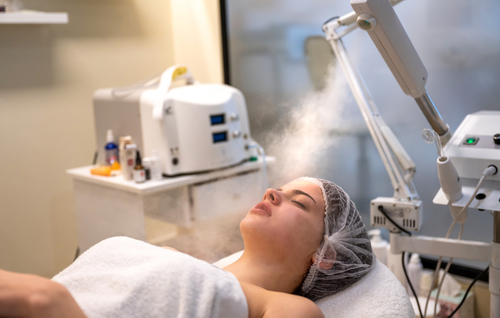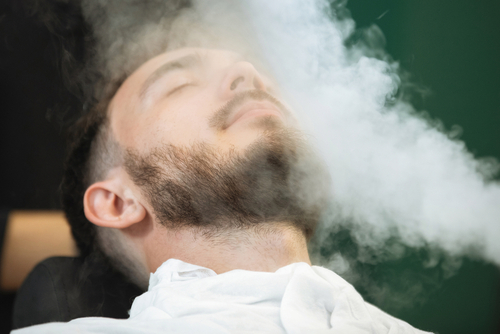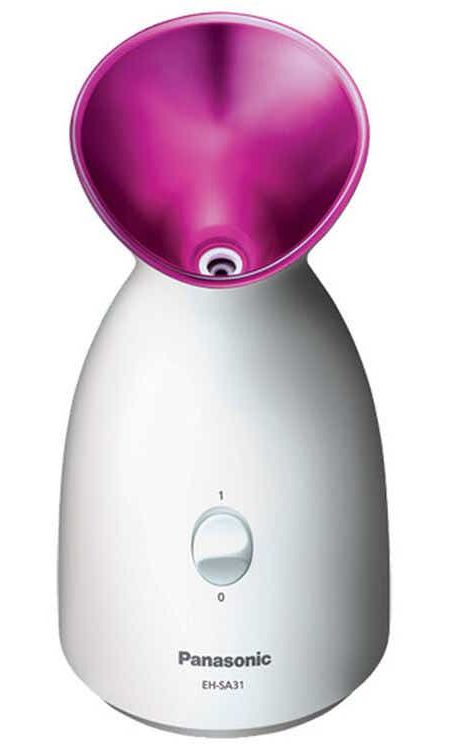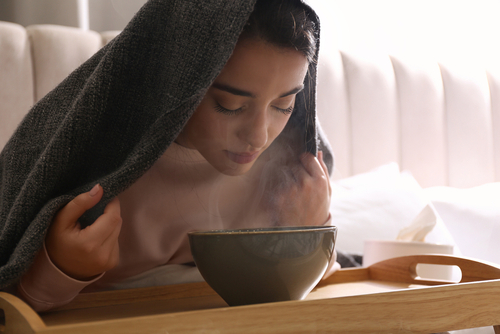Getting a good facial involves more than just a few slices of cucumber for your eyes and painting your face with egg whites. Taking care of your skin and achieving a healthy glow sometimes involves getting steamy…
While facial steaming is typically reserved for spa services, the growing interest in this skincare trend has seen at-home facial steamers become somewhat of a must-have in your beauty tool kit. But are they right for everyone?
What’s a facial steamer?

A facial steamer produces bursts of steam over your face to unclog pores and purify the skin. The steam works to extract oil, dirt, sebum (naturally occurring oil) and other nasties trapped in your pores that can cause skin problems like blackheads and acne.
Facial steaming is typically the second step of a skincare routine, just after cleansing. A facial steamer generally comes with a water tank, which is filled with distilled water and heated up. Once the water gets hot enough, it will begin to evaporate and produce warm mist.
Is steam good for your face?
Facial steaming can be great for achieving softer and less ‘textured’ skin. Exposing your skin to heat is said to help open pores and draw out oils, dirt and sebum trapped inside. Warm air can also hydrate the skin and facial hair and improve circulation. Other claimed benefits of facial steaming include helping to reduce the appearance of wrinkles and fine lines, to increase the production of collagen and elastin (i.e. minimise loose skin) and prevent breakouts.
What are the benefits of steaming your face?
The main benefits to using a facial steamer at home, include:
- Cleanses and unclogs pores: applying heat or steam to your skin opens the pores, making it easier to draw out oil, dirt and sebum trapped deep inside.
- Hydrates the skin: steam can encourage healthy oil production to soothe your skin and prevent it from drying out, as long as you don’t expose your skin to hot vapour too frequently or for extended periods.
- Minimises blackheads: while sebum keeps skin and hair hydrated, it’s important to unclog your pores to remove excess sebum as it could cause blackheads and skin congestion.
- Gets rid of pimples: opening the pores gets rid of the trapped oils, dirt and dead skin that can contribute to acne and breakouts.
- Reduces fine lines and wrinkles: steaming can promote cell regeneration and improve collagen production and elasticity because heat increases blood circulation, helping bring in more oxygen.
- Increases potential effectiveness of skincare products: warm air can create the ideal environment for skincare products to penetrate your skin, and make it more receptive to the snail mucin serum or whatever else is in your arsenal.
- Saves you money: face steaming at home instead of going to a spa should save you big bucks in the long run.

Who should not use facial steaming?
It’s important to note that facial streaming is not suitable for all types of skin. People with sensitive or dry skin, or those with skin conditions such as eczema, may find that hot showers, saunas and other high-temperature environments tend to strip their natural oils and dry out their skin.
People with the following skin conditions may find facial steaming unsafe for their skin:
- Eczema
- Psoriasis
- Inflamed skin
- Active acne (i.e. where the skin is inflamed and there are red bumps with white or yellow pus, or where the bumps are sensitive to touch)
- Rosacea
- Seborrheic dermatitis.
It’s also worth asking a professional to have a look at your skin and discuss whether facial steaming is suitable for you.
How do you use a facial steamer?

The way to use a facial steamer varies depending on the product/model you use. But here are a few steps that may commonly apply:
- Remove any makeup and cleanse your face to get rid of impurities like oil and dirt, then dab your skin dry with a clean towel. Also, push back any hair away from your face.
- Exfoliate the skin to scrub off any dead cells.
- Fill the water tank of the face steamer with lukewarm, distilled water.
- Re-attach the water tank to the face steamer and follow instructions on how to heat up the water.
- Some facial steamers can be placed on a table or flat surface to allow the mist to ‘whiff’ over your face, while other types of models are more compact and held slightly away from the face. Start steaming your face for a couple of minutes before checking your face for any irritation.
- If there are no problems, continue steaming for about five to 10 minutes (or whatever time is stipulated in the instructions manual). Depending on the product, you might also need to take periodic breaks.
- Once you’re done, wipe your face dry and let your skin breathe.
What to do after steaming your face
It’s very important that you resume your skincare routine straight after the facial, otherwise, the moisture will begin to evaporate and dry out the skin. Below are a few basic steps to help you make the most out of your facial steaming:
- Clean your face after steaming to remove any loose gunk extracted.
- After steaming your face, you can use a sheet mask to pull out additional impurities from the pores. Alternatively, you can do a facial peel to reduce the appearance of pores, which may be especially useful since the steaming process enlarges pores. A peel can similarly minimise the appearance of pores, plus reduce fine lines and wrinkles and correct uneven skin tone.
- If you don’t want to use a mask, jump into your skincare routine immediately after completing your facial steam.
How to steam your face without a facial steamer

You don’t need to fork out tons of cash (or any money) to get the same type of benefits you would get from a facial steamer device or booking an appointment with your esthetician. Here are two ways to steam your face at home (for free):
- Put your face over a bowl (or sink) filled with hot water
- Place a warm towel over your face
Even humidifiers have been claimed to provide some skin benefits, particularly in colder months when the skin is dryer and there’s a greater need to keep the skin hydrated.
How long should you use a facial steamer for?
Popular celebrity dermatologist Dr. Dennis Gross recommends starting off by steaming your face for two minutes before checking how your skin looks and, most importantly, feels. Of course, discontinue use if your skin appears or feels irritated.
Facial steaming shouldn’t be done for more than five minutes, or less, depending on the product/model you’re using. If you’re new to facial steaming, it’s a good idea to start with the shorter recommended time.
How often should you use a facial steamer?
There are varying opinions on how many times face steaming should be performed, although certain dermatologists suggest it should not be done more than once a week. Some brands such as Panasonic and Dr. Gross recommend using a facial steamer three times per week on average, but this depends on the specific product and the unique characteristics of your skin.
Is it safe to use a facial steamer every day?
If you want to steam your face, the motto ‘a little goes a long way’ applies. Experts suggest facial steamers shouldn’t be used every day or for extended periods because exposing the skin to heat apparently causes blood vessels to dilate, which can potentially damage the skin. Some effects might include flushing, inflammation, or the worsening of existing skin conditions like rosacea.
Picture credits: Julio Ricco/Shutterstock.com, Bojan Milinkov/Shutterstock.com, New Africa/Shutterstock.com, Fotosparrow/Shutterstock.com.
Original Author: Tahnee-Jae Lopez-Vito


Share this article